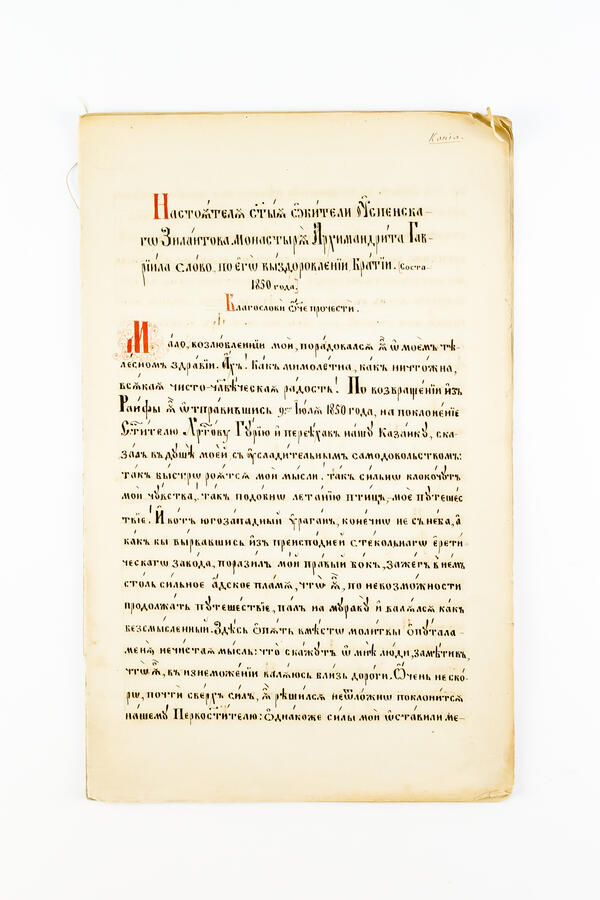The museum houses a valuable manuscript written with a fine calligraphic pen and ink. It was created by the abbot of the Zilantov Holy Dormition Monastery Gavriil in 1850. The work is called “The Address to His Brethren Upon Recovery, ” in which the rector spoke about the miraculous deliverance from the disease with the help of the Mother of God.
The text begins with a description of the trip to Kazan. There Saint Gavriil visited the Annunciation Cathedral. He wanted to worship the holy relics of the first Kazan Archbishop Guriy.
The story turned out to be lively and dramatic: the author vividly recounted how, after crossing the Kazanka River, he felt pain in his right side. He compared it to a southwestern hurricane and lamented that it was probably connected, among other things, with heretics: at that moment, he was passing an Old Believer — in the text “heretical” — glass factory. The saint felt severe pain, left the carriage and sank to the ground.
Then Father Gavriil turned to the genre of lamentation — this is the name of a poetic technique designed to pity the public. The saint wrote a whole piece about sins, and expressed his annoyance that the pilgrimage trip had failed. After a short digression, he informed the readers of his return to the monastery.
There, on the day of the celebration of the Nativity of the Most Holy Theotokos, he saw a wonderful dream: the Mother of God appeared to him, accompanied by a host of saints. One of the elderly saints, who was dressed as a monk, drew special attention. The Virgin Mary turned to the archimandrite with the question, “Have you forgotten me?”, then pointed to the saint and asked, “Have you forgotten this elderly man?”
Immediately after this, the abbot remembered the Bogolyubovo icon of the Mother of God lost in the monastery. The elderly monk reminded him of the deceased abbot of the monastery, Joseph — it was above his burial place that the icon used to be.
Therefore, the author concluded that his illness was associated with negligence in relation to the Bogolyubovo icon of the Mother of God and the abbot Joseph. It was necessary to restore the veneration of the image and the recitation of prayers for the dead. After correcting the mistake, Archimandrite Gabriel again saw a dream in which the Virgin blessed him. The text ends with a majestic prayer of repentance imitating the ancient holy fathers and a vow to study the life of the late Joseph.
The text also includes a description of the vision of a certain virgin. She saw how the deceased abbot Joseph was praying to Jesus Christ that Kazan would avoid an epidemic of cholera. The vision is vividly described, with various images of half-human-half-animals to imitate ancient texts. The manuscript ends with a ritual praise (Magnification) and the text of a hymn (Troparion) to the Bogolyubovo icon of the Mother of God.
The text begins with a description of the trip to Kazan. There Saint Gavriil visited the Annunciation Cathedral. He wanted to worship the holy relics of the first Kazan Archbishop Guriy.
The story turned out to be lively and dramatic: the author vividly recounted how, after crossing the Kazanka River, he felt pain in his right side. He compared it to a southwestern hurricane and lamented that it was probably connected, among other things, with heretics: at that moment, he was passing an Old Believer — in the text “heretical” — glass factory. The saint felt severe pain, left the carriage and sank to the ground.
Then Father Gavriil turned to the genre of lamentation — this is the name of a poetic technique designed to pity the public. The saint wrote a whole piece about sins, and expressed his annoyance that the pilgrimage trip had failed. After a short digression, he informed the readers of his return to the monastery.
There, on the day of the celebration of the Nativity of the Most Holy Theotokos, he saw a wonderful dream: the Mother of God appeared to him, accompanied by a host of saints. One of the elderly saints, who was dressed as a monk, drew special attention. The Virgin Mary turned to the archimandrite with the question, “Have you forgotten me?”, then pointed to the saint and asked, “Have you forgotten this elderly man?”
Immediately after this, the abbot remembered the Bogolyubovo icon of the Mother of God lost in the monastery. The elderly monk reminded him of the deceased abbot of the monastery, Joseph — it was above his burial place that the icon used to be.
Therefore, the author concluded that his illness was associated with negligence in relation to the Bogolyubovo icon of the Mother of God and the abbot Joseph. It was necessary to restore the veneration of the image and the recitation of prayers for the dead. After correcting the mistake, Archimandrite Gabriel again saw a dream in which the Virgin blessed him. The text ends with a majestic prayer of repentance imitating the ancient holy fathers and a vow to study the life of the late Joseph.
The text also includes a description of the vision of a certain virgin. She saw how the deceased abbot Joseph was praying to Jesus Christ that Kazan would avoid an epidemic of cholera. The vision is vividly described, with various images of half-human-half-animals to imitate ancient texts. The manuscript ends with a ritual praise (Magnification) and the text of a hymn (Troparion) to the Bogolyubovo icon of the Mother of God.



